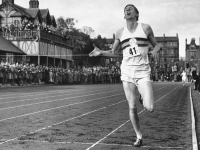The Four-Minute Man, Forever

Franz Stampfl, his coach, implored him to run in a meet between Oxford and the Amateur Athletic Association: “He said to me, ‘Although the conditions are not ideal, if you don’t take this opportunity, you might not forgive yourself for the rest of your life.’ He was right.”
By Jesse Will, The New Yorker
On a recent Saturday, Chipping Norton, a small village in the English Cotswalds, hosted a literary festival that included such discussion topics as “Shag, Shoot, or Marry,” which weighed the relative merits of Heathcliff, Lord Rochester, and Mr. Darcy.
Another heroic British character made an appearance: Sir Roger Bannister, a neurologist and the first man to run a Mile in less than 4 minutes. On Tuesday, that achievement turns sixty years old; Bannister is now eighty-five. He had travelled a half hour from his Oxford home to speak about about his new memoir, Twin Tracks, at a small Methodist chapel.
Bannister, 85, entered from the rear of the church, leaning on crutches with forearm supports that bunched his black suit sleeves. (Days later, he would reveal to BBC Radio Oxford that he was diagnosed with Parkinson’s in 2011.) Addressing the small crowd, he said it was a great irony that, as a clinical neurologist, he was having difficulty walking. He took his seat near an old pipe organ, then unstrapped a black dress watch and placed the timepiece on a table, its face turned away from his.
Fewer people have run a sub-4 minute Mile than have climbed Mt. Everest. The current record is just over 3 minutes and 43 seconds, though during the talk Bannister flung his long hands up and insisted that runners have only shaved thirteen seconds off his time (3 minutes, 59 and four-tenths seconds), since the modern surface is worth four seconds in comparison with the cinder track that he had run on. Bannister’s competitive spirit was flickering, and the crowd laughed. He seemed young.
Bannister explained that his failure to win medal in the 1500 meters at the 1952 Helsinki Olympics ignited his two-year quest to break the 4-minute mark—a plotline that the producers of “Downton Abbey” recently announced they plan to adapt for a BBC miniseries.
A medical student at Oxford, Bannister took a cerebral approach to the 4-minute barrier. He studied running’s physiological demands, measured his own oxygen-consumption levels, and produced papers with titles like “The Carbon Dioxide Stimulus to Breathing in Severe Exercise.” Bannister discovered that running consistent lap times demanded less oxygen than varying the pace. So he focussed on his quarter-mile splits. During lunch breaks, he would run ten of them, stopwatch in hand, punctuated by two-minute breaks. In five months, he brought down the average time he could run these intervals from sixty-three seconds to fifty-nine.
Bannister was racing more than just the clock: two other runners, Wes Santee, an American, and John Landy, Australian, were also nearing the 4-minute mile. “It all came down to whoever had the first chance in tolerable weather,” Bannister said.
Bannister recalled his trepidation, on the blustery night of May 6, 1954, when Franz Stampfl, his coach, implored him to run in a meet between Oxford and the Amateur Athletic Association: “He said to me, ‘Although the conditions are not ideal, if you don’t take this opportunity, you might not forgive yourself for the rest of your life.’ He was right.”
Bannister had trained just enough. As he crossed the finish line, his vision failed and his blood pressure fell. “I would have collapsed if someone wasn’t there to hold me,” he said. Later, as a doctor, Bannister would study how fainting happens.
Bannister broke the 4-minute barrier once more, at the British Empire and Commonwealth Games, in August 1954, beating Landy in The Mile of the Century, and soon after he retired from sport to focus on medicine. In his 40-year career, he researched and diagnosed failures of the autonomic nervous system, which controls involuntary functions, like heart rate and breathing. He defined several rare disorders and wrote a textbook, now in its fifth edition.
Continue reading at: newyorker.com
